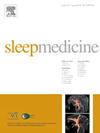High sleep reactivity in shift workers is associated with increased sleep disturbance, mood problems, and reduced quality of life
IF 3.8
2区 医学
Q1 CLINICAL NEUROLOGY
引用次数: 0
Abstract
Introduction
Shift work disrupts circadian rhythms, causing sleep and mood problems. Sleep reactivity—the sensitivity of sleep to stress—may affect how shift workers cope with these disruptions. This study investigated the relationship between sleep reactivity and shift work, exploring associations between sleep reactivity and sleep disturbance, mood symptoms, and quality of life in shift workers.
Methods
In a cross-sectional design, 132 participants (79 shift workers and 53 controls) were assessed using the Ford Insomnia Response to Stress Test (FIRST), Insomnia Severity Index (ISI), Pittsburgh Sleep Quality Index (PSQI), Epworth Sleepiness Scale (ESS), Beck Depression Inventory (BDI), Beck Anxiety Inventory (BAI), and World Health Organization Quality of Life (WHOQOL). We compared the self-reported measurements between shift workers and controls. Two-way ANOVA was performed to explore the interaction effects between shift work and sleep reactivity on sleep, mood parameters, and quality of life. Multiple linear regression analysis was conducted to identify factors associated with sleep, mood, and quality of life among shift workers.
Results
Shift workers scored higher on ISI and BDI compared to controls. Two-way ANOVA revealed an interaction effect between shift work and sleep reactivity on WHOQOL. Regression analysis indicated that high sleep reactivity was associated with higher ISI, BDI, BAI, and lower WHOQOL among shift workers.
Conclusion
Sleep reactivity significantly affected shift worker’s quality of life. Our findings indicate that high sleep reactivity in shift workers was associated with increased sleep disturbance, mood problems, and decreased quality of life, implying that sleep reactivity may predict shift work tolerance.
倒班工人的高睡眠反应性与睡眠障碍增加、情绪问题和生活质量下降有关。
导读:轮班工作会扰乱昼夜节律,导致睡眠和情绪问题。睡眠反应——睡眠对压力的敏感性——可能会影响轮班工作者应对这些干扰的方式。本研究旨在探讨倒班工人睡眠反应性与睡眠障碍、情绪症状和生活质量之间的关系。方法:采用横断面设计,对132名参与者(79名倒班工人和53名对照)进行评估,采用福特失眠压力反应测试(FIRST)、失眠严重程度指数(ISI)、匹兹堡睡眠质量指数(PSQI)、Epworth嗜睡量表(ESS)、贝克抑郁量表(BDI)、贝克焦虑量表(BAI)和世界卫生组织生活质量量表(WHOQOL)。我们比较了轮班工人和对照组之间自我报告的测量结果。采用双向方差分析探讨轮班工作和睡眠反应性对睡眠、情绪参数和生活质量的交互影响。采用多元线性回归分析来确定轮班工人的睡眠、情绪和生活质量的相关因素。结果:与对照组相比,轮班工人在ISI和BDI方面得分更高。双向方差分析显示轮班工作和睡眠反应对WHOQOL有交互作用。回归分析表明,高睡眠反应性与倒班工人较高的ISI、BDI、BAI和较低的WHOQOL相关。结论:睡眠反应性显著影响轮班工人的生活质量。我们的研究结果表明,倒班工人的高睡眠反应性与睡眠障碍、情绪问题和生活质量下降的增加有关,这意味着睡眠反应性可以预测轮班工作的耐受性。
本文章由计算机程序翻译,如有差异,请以英文原文为准。
求助全文
约1分钟内获得全文
求助全文
来源期刊

Sleep medicine
医学-临床神经学
CiteScore
8.40
自引率
6.20%
发文量
1060
审稿时长
49 days
期刊介绍:
Sleep Medicine aims to be a journal no one involved in clinical sleep medicine can do without.
A journal primarily focussing on the human aspects of sleep, integrating the various disciplines that are involved in sleep medicine: neurology, clinical neurophysiology, internal medicine (particularly pulmonology and cardiology), psychology, psychiatry, sleep technology, pediatrics, neurosurgery, otorhinolaryngology, and dentistry.
The journal publishes the following types of articles: Reviews (also intended as a way to bridge the gap between basic sleep research and clinical relevance); Original Research Articles; Full-length articles; Brief communications; Controversies; Case reports; Letters to the Editor; Journal search and commentaries; Book reviews; Meeting announcements; Listing of relevant organisations plus web sites.
 求助内容:
求助内容: 应助结果提醒方式:
应助结果提醒方式:


